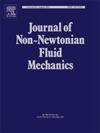Oldroyd-B粘弹性流体惯性矩形微通道中球体的平衡位置和旋转行为
IF 2.7
2区 工程技术
Q2 MECHANICS
引用次数: 0
摘要
采用直接强迫/虚拟域方法研究了Oldroyd-B粘弹性流体惯性矩形微通道中球体的平衡位置和旋转行为。结果表明,在惯性矩形通道中,长形(扁圆)球体的弹惯性迁移存在5种平衡位置和4种旋转行为。随着弹性数的减小,球体逐渐转变为边角(CO)、通道中心线(CC)、近边角(NCO)、近通道中心(NCC)和长壁等分线(BLW)平衡位置,NCO和NCC平衡位置是本文新发现的。当流体弹性较大时,只有大球体显示异常的离中心NCC平衡位置。随着流体惯量的增加,颗粒附近的诱导横向迁移速度增强,诱导流线将所有颗粒推离CC平衡位置。球形颗粒表现出最高的诱导速度,其次是扁圆球体,而长条形球体诱导的横向迁移速度最低,并且始终表现出离通道中心最近的距离。颗粒粒径越小,流体弹性越大,颗粒越靠近通道中心。这些结果对设计高分离效率的微流控芯片具有一定的指导意义。本文章由计算机程序翻译,如有差异,请以英文原文为准。
Equilibrium position and rotational behaviours of spheroid in an inertial rectangular microchannel flow of Oldroyd-B viscoelastic fluid
Equilibrium position and rotational behaviours of spheroid in an inertial rectangular microchannel flow of Oldroyd-B viscoelastic fluid is studied by the direct forcing/fictitious domain method. The results show that there are five kinds of equilibrium positions and four (three) kinds of rotational behaviours for the elasto-inertial migration of prolate (oblate) spheroids in an inertial rectangular channel flow. The spheroids gradually change to the corner (CO), channel centreline (CC), near corner (NCO), near channel centre (NCC) and bisector of the long wall (BLW) equilibrium positions as the elastic number decreases, the NCO and NCC equilibrium positions are newly found in the present works. When the fluid elasticity is large, only the large sphere displays the anomalous off-centreline NCC equilibrium position. With increasing the fluid inertia, the induced lateral migration velocity near the particle is enhanced, and the induced streamlines push all particles away from the CC equilibrium position. Spherical particles exhibit the highest induced velocity, then followed by the oblate spheroids, while prolate spheroids induce the lowest lateral migration velocity and consistently exhibit the closest distance to the channel centre. The particles are closer to the channel centre with decreasing the particle size, and with increasing the fluid elasticity. Those results are useful for designing a microfluidic chip with high separation efficiency.
求助全文
通过发布文献求助,成功后即可免费获取论文全文。
去求助
来源期刊
CiteScore
5.00
自引率
19.40%
发文量
109
审稿时长
61 days
期刊介绍:
The Journal of Non-Newtonian Fluid Mechanics publishes research on flowing soft matter systems. Submissions in all areas of flowing complex fluids are welcomed, including polymer melts and solutions, suspensions, colloids, surfactant solutions, biological fluids, gels, liquid crystals and granular materials. Flow problems relevant to microfluidics, lab-on-a-chip, nanofluidics, biological flows, geophysical flows, industrial processes and other applications are of interest.
Subjects considered suitable for the journal include the following (not necessarily in order of importance):
Theoretical, computational and experimental studies of naturally or technologically relevant flow problems where the non-Newtonian nature of the fluid is important in determining the character of the flow. We seek in particular studies that lend mechanistic insight into flow behavior in complex fluids or highlight flow phenomena unique to complex fluids. Examples include
Instabilities, unsteady and turbulent or chaotic flow characteristics in non-Newtonian fluids,
Multiphase flows involving complex fluids,
Problems involving transport phenomena such as heat and mass transfer and mixing, to the extent that the non-Newtonian flow behavior is central to the transport phenomena,
Novel flow situations that suggest the need for further theoretical study,
Practical situations of flow that are in need of systematic theoretical and experimental research. Such issues and developments commonly arise, for example, in the polymer processing, petroleum, pharmaceutical, biomedical and consumer product industries.

 求助内容:
求助内容: 应助结果提醒方式:
应助结果提醒方式:


